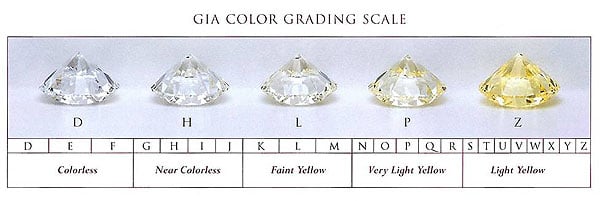For most people, buying a diamond ring is a big thing and a lot of people ask – where do I start? What do I look for? How do I get the most for my money?
Virtually everyone who buys a diamond, will have a budget and will therefore need to compromise on something in terms of the ‘4 C’s’ – (Carat, Clarity, Cut & Colour). So for example, if a very large diamond is the priority, you might need to compromise colour/clarity for the sake of having a higher carat weight. Alternatively, if a very high quality diamond, with excellent clarity and colour is the priority, you might want to choose a smaller diamond with a lower carat weight. We are happy to guide you through this essential step of your diamond buying experience.
The 4 C’s
The 4C’s of diamond quality is the general universal language used to describe the attributes of a diamond. Taken together, this helps to determine a diamond’s overall quality. Quality is ultimately tied to price, so it’s helpful to gain some familiarity with the 4C’s so that you understand what you’re buying.
The 4 C’s – ‘Carat’
Diamonds are weighed in metric carats. For reference, a small paper clip weighs about two carats.
As a very general rule, a two carat diamond is likely to cost approximately four times the price of an equivalent one carat diamond. A three carat diamond is likely to cost approximately nine times the price of an equivalent one carat diamond. Hence, as the carat weight of a diamond gradually increases, the price increases much more drastically.
The 4 C’s – ‘Clarity’
Diamonds are created by nature under tremendous heat and pressure. Nearly all diamonds contain unique internal characteristics called inclusions and external characteristics called blemishes. Many clarity characteristics are too tiny to be seen by anyone other than a trained gemologist using magnification. The GIA Clarity Scale contains 11 grades ranging from Flawless to Included.
The Gemological Institute of America (GIA) developed the most widely used diamond clarity grade scale. All grade descriptions are based on a skilled grader working with proper magnification and lighting. The following list summarises the various grades:
FI = Flawless: No inclusions or blemishes visible at 10x magnification.
IF = Internally Flawless: No inclusions and only minor blemishes visible at 10x magnification.
VVS1 = Very, Very Slightly Included: Minute inclusions extremely difficult to see at 10x magnification.
VVS2 = Very, Very Slightly Included: Minute inclusions very difficult to see at 10x magnification.
VS1 = Very Slightly Included: Minor inclusions fairly difficult to see at 10x magnification.
VS2 = Very Slightly Included: Minor inclusions fairly easy to see at 10x magnification.
SI1 = Slightly Included: Noticeable inclusions easy to see at 10x magnification.
SI2 = Slightly Included: Noticeable inclusions very easy to see at 10x magnification.
I1 = Included: Significant inclusions usually visible without magnification.
I2 = Included: Significant inclusions easily visible without magnification.
I3 – Included: Significant inclusions obvious without magnification; may also threaten durability.
It is important to consider that most diamonds have significant inclusions within their internal structure. Many SI2 and even I1 grade diamonds have a beautiful ‘eye clean’ appearance. The truth is that many diamonds you will see in high street jewellery shop windows are probably around the I1 grade for clarity and yet can often look stunning. Therefore you don’t necessarily need a ‘VVS’/’VS’ grade diamond to fulfil your needs, if you just want a sparkly diamond on your finger.
‘I1’ clarity graded diamonds come with slight ambiguity, because some have very visible inclusions and some do not, which gives rise to a small spectrum of different ‘I1’ grade types (some diamond labs invented the ‘SI3’ grade to differentiate between better and worse ‘I1’ grades).
The type of inclusion characteristic is also an important concept to consider. For example, whilst ‘clouds’ might prevent a diamond from sparkling as much – a ‘feather’ might stand out as more obvious, but have minimal effect on the diamonds cosmetic sparkle appearance.
Please consider that our photographs are ‘blown up’ significantly in size and therefore any inclusions affecting the clarity of the diamond will look much more apparent than in real life.
The 4 C’s – ‘Colour’
Colourless diamonds are rare and highly valued. The GIA colour scale uses letters to represent the absence of colour, beginning with ‘D’ (truly colourless) and ending at Z (light yellow or brown). Colour distinctions can be subtle and only visible to the trained eye, but the differences can have a significant impact on price.
When choosing a diamond, it is important to consider that whilst a colourless diamond is more expensive, sometimes it can be difficult to tell that diamonds with tinted colour shades (i.e., K-M) have this colour unless they are compared directly next to a colourless diamond. For this reason, purchasing a diamond with a tint of colour, can be an excellent way of making a larger or higher clarity diamond more affordable. According to the above colour scale, would you say that the ‘near colourless’ or K-M’ colour range look particularly ‘yellow’ or ‘brown’? If not, purchasing a diamond from this range can be an excellent way to save money.
Please consider that when photographing diamonds – cameras tend to be highly sensitive to detecting any tint of colour and will therefore amplify this in images. So for any diamonds we have photographed which are below the ‘colourless range’ – they will likely look more tinted compared with real life.
The 4 C’s – ‘Cut’
While diamonds can be fashioned into different shapes, the term ‘cut’ refers to how a diamond’s complex proportions and angles relate to light. A number of factors influence a diamond’s cut grade, including its overall face-up appearance, design and craftsmanship. The GIA cut scale for standard round brilliant cut diamonds ranges from ‘Excellent’ to ‘Poor’.
Alongside clarity and colour, the cut grade of a diamond is important in determining how much it sparkles.
Advice Around Diamond Grading
Different diamond grading laboratories have different standards of grading. It is therefore wrong to assume that two diamonds of the same grade, are the same quality, if they have been graded by two different diamond grading establishments.
Diamonds with ‘in-house’ diamond grading certificates or certification from less reputable diamond grading laboratories, are likely to have been graded more generously than if the same diamond was sent to a strict diamond grading laboratory such as ‘GIA’, ‘AGS’, ‘Anchorcert’, ‘HRD’ or ‘IGI’. For example a diamond graded as ‘VS1’ clarity and ‘E’-colour by a less reputable diamond grading laboratory, could easily be graded as ‘SI1’ clarity and ‘H’-Colour by more strict and reputable diamond laboratory.
For this reason, a diamond graded for example as ‘I1’ clarity and ‘K’-colour may sound as though it is fairly low down on the clarity/colour grading scales. However, if graded in accordance to the strict grading standards practiced by GIA, AGS, IGI, Anchorcert or HRD for example, visually, this could still be a very beautiful diamond and should not be automatically dismissed, if it’s optical appearance meets your requirements.
We certainly try to represent the stock we have the best we can, but we would always advise having a look at a diamond in person, with your own eyes. We are always happy to try to accommodate this for you where possible.
Please feel free to get in touch and ask any questions about our diamond buying guide.

